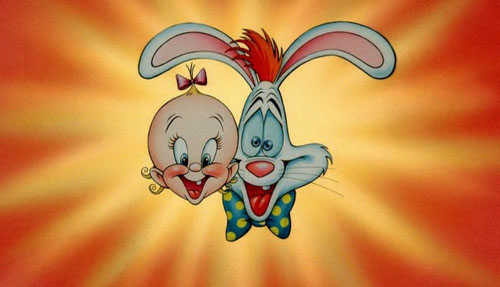
Roger Rabbit Problems. From Los Angeles Times Calendar section June 22, 1998, animator Dave Spafford who drew the piano duel between Donald Duck and Daffy Duck in Who Framed Roger Rabbit said, “Having the camera constantly moving at such a subtle pace was scary at first. But it helped keep the characters alive. If the live actor is standing still and the camera is locked down, the animation can go dead and the seperation between the cartoon character and the actor becomes obvious. But when the camera’s moving, it covers up that separation.
“One other problem that we had was that Bob Hoskins was so good. He stole the show in every shot. If he seemed more animated than the cartoon characters, we’d have really been in trouble. We had to pull out all the stops to compete with him.”
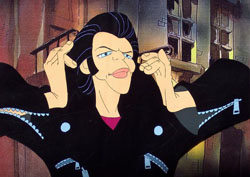 Bakshi Speaks. Animator and director Ralph Bakshi in the November 1982 issue of American Premiere magazine talking about the recent release of his animated feature Hey Good Lookin’ said, “Its strong points are good animation and a story that’s never been told before in that medium. It’s an honest story about the 1950s from a New York point of view – sexual attitudes among kids, what they considered fun, how they spent their time. It’s really a personal film because it’s about New York and New York is not like the rest of the world. It’s inherently tougher, inherently…different. There’s not as much blue sky.”
Bakshi Speaks. Animator and director Ralph Bakshi in the November 1982 issue of American Premiere magazine talking about the recent release of his animated feature Hey Good Lookin’ said, “Its strong points are good animation and a story that’s never been told before in that medium. It’s an honest story about the 1950s from a New York point of view – sexual attitudes among kids, what they considered fun, how they spent their time. It’s really a personal film because it’s about New York and New York is not like the rest of the world. It’s inherently tougher, inherently…different. There’s not as much blue sky.”
Actually, there were at least five different versions of the film before this all animated version was released. I remember seeing a sneak preview of the second version sometime in 1976 that combined live action sequences with animation. For instance, the “Crazy” character had a live action dad who was a policeman.
 Rikki Tikki Tavi Study. Chuck Jones, interviewed in Business Screen magazine (Aug/Sept 1982) said, “When we were doing Rikki Tikki Tavi, we had to study some film of a cobra striking so that we could be accurate in showing a fight between a mongoose and a cobra. In one clip, the cobra actually struck the camera. Now, apparently, this cobra was eight feet away when he struck the camera and yet there was only one frame between the two positions!
Rikki Tikki Tavi Study. Chuck Jones, interviewed in Business Screen magazine (Aug/Sept 1982) said, “When we were doing Rikki Tikki Tavi, we had to study some film of a cobra striking so that we could be accurate in showing a fight between a mongoose and a cobra. In one clip, the cobra actually struck the camera. Now, apparently, this cobra was eight feet away when he struck the camera and yet there was only one frame between the two positions!
“He traveled eight feet in a twenty-fourth of a second. That’s pretty fast. The cobra draws back a tiny bit – perhaps a thousandth of a second – but it’s enough to warn the mongoose to pull away. This is a case where animation cannot exaggerate the action because when you have only one frame to work with, the only way you could show it would be with strobe lights at a thousand frames a second.”
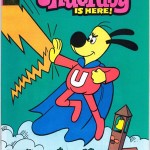 Tezuka Cameo. In Gold Key’s (also released with the Whitman logo) comic book Underdog #23 (Feb. 1979), there is a multi-page appearance of a beret-wearing caricature of famed animator and director Osamu Tezuka in the six page story “Wedding Bells in Outer Space”. Tezuka’s character sees Underdog’s girlfriend abducted by a flying saucer in the park and tells the superhero. It is a version of Tezuka’s own self-caricature and the figure is even wearing a t-shirt with a “hyotonsugi” (one to Tezuka’s creations) on it. Animator Gary Terry, who moonlighted as a cartoonist for Western Publishing comic books out of the New York office, drew this story.
Tezuka Cameo. In Gold Key’s (also released with the Whitman logo) comic book Underdog #23 (Feb. 1979), there is a multi-page appearance of a beret-wearing caricature of famed animator and director Osamu Tezuka in the six page story “Wedding Bells in Outer Space”. Tezuka’s character sees Underdog’s girlfriend abducted by a flying saucer in the park and tells the superhero. It is a version of Tezuka’s own self-caricature and the figure is even wearing a t-shirt with a “hyotonsugi” (one to Tezuka’s creations) on it. Animator Gary Terry, who moonlighted as a cartoonist for Western Publishing comic books out of the New York office, drew this story.
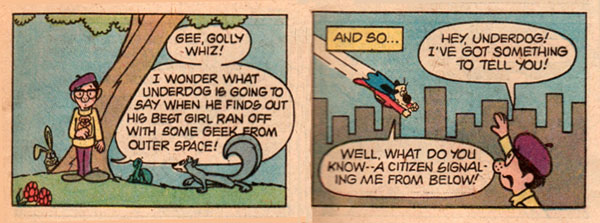
Two panels from Underdog #23 (Feb. 1979) – thanks to Alfons Moline
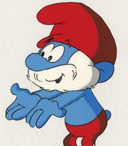 Smurfy Success. In the September 5, 1982 issue of the Cedar Rapids Gazette newspaper, animation producer Gerald Baldwin talked about the success of Hanna-Barbera’s The Smurfs Saturday morning series, “It came along at the right moment in time, perhaps, when Saturday morning children’s TV was saturated with superheroes and mindless stories. It was the same problem you could say that afflicts prime-time television. The Smurfs simply have the ingredients for good stories – clearly defined, good characters…”
Smurfy Success. In the September 5, 1982 issue of the Cedar Rapids Gazette newspaper, animation producer Gerald Baldwin talked about the success of Hanna-Barbera’s The Smurfs Saturday morning series, “It came along at the right moment in time, perhaps, when Saturday morning children’s TV was saturated with superheroes and mindless stories. It was the same problem you could say that afflicts prime-time television. The Smurfs simply have the ingredients for good stories – clearly defined, good characters…”
 A Ward Kimball Story You Probably Never Heard. In the January 24, 1988 edition of the Los Angeles Times there was a reported story of two light planes that collided the day before over the San Gabriel Valley sending one plummeting into the front yard of animation legend Ward Kimball at 2:13 p.m. shearing a large magnolia tree in two. It crashed three feet from Kimball’s studio. Debris from the plane was scattered throughout the neighborhood including a propeller that crashed through the roof of a house a block away.
A Ward Kimball Story You Probably Never Heard. In the January 24, 1988 edition of the Los Angeles Times there was a reported story of two light planes that collided the day before over the San Gabriel Valley sending one plummeting into the front yard of animation legend Ward Kimball at 2:13 p.m. shearing a large magnolia tree in two. It crashed three feet from Kimball’s studio. Debris from the plane was scattered throughout the neighborhood including a propeller that crashed through the roof of a house a block away.
The plane struck nose-down killing both people aboard. The other plane was able to make a safe emergency landing at Burbank Airport. Ward and his wife and daughter Kelly were inside the house and were not hurt.
“We heard a loud roar and two seconds later we heard the crash,” said Ward who was 72 year old at the time. “It went nose first and collapsed just like a foam cup.” The Kimballs had lived in the one story house on a two acre lot since 1939.
What’s In A Name? One of my favorite animation books (and still recommended by me today) is Leonard Maltin’s Of Mice and Magic (Plume 1980) especially because of its filmographies. Jerry Beck is credited as a research associate. Jerry did a great deal of research from compiling filmographies, screening cartoons, helping on interviews and more.
I don’t think modern animation fans fully realize how valuable this book was in those pre-internet days. So where did that title come from? Well, for about three years the book was simply referred to as “Leonard’s Cartoon Book”. One night as the deadline was approaching to submit the final manuscript, Jerry Beck told Leonard that they better settle on an official title. Jerry felt an actual cartoon title like “What Makes Daffy Duck?” would be a good choice. Leonard liked something along the lines of “Wabbits and Ducks” but Jerry pointed out that in the Summer of 1974 animation historian Michael Barrier had written an article for the AFI Report titled “Of Mice, Wabbits, Ducks and Men”. Finally, Leonard was going to settle on “Of Mice and Men” even though that was also the title of the John Steinbeck classic novel.
Later that week, Leonard’s wife, Alice was typing up the Famous Studios filmography (She had typed the entire manuscript in those pre-computer days) and, knowing the discussion between Jerry and Leonard, came across the Paramount cartoon release for February 1953, a Herman and Katnip cartoon called “Of Mice and Magic”. The title summed up the duo’s feelings about American animation history and was used. Ironically, the title came from Leonard’s least favorite cartoon studio — but not Jerry’s.



 Jim Korkis is an internationally respected animation historian who in recent years has devoted his attention to the many worlds of Disney. He was a columnist for a variety of animation magazines. With his former writing partner, John Cawley, he authored several animation related books including The Encyclopedia of Cartoon Superstars, How to Create Animation, Cartoon Confidential and Get Animated’s Animation Art Buyer’s Guide. He taught animation classes at the Disney Institute in Florida as well as instructing classes on acting and animation history for Disney Feature Animation: Florida.
Jim Korkis is an internationally respected animation historian who in recent years has devoted his attention to the many worlds of Disney. He was a columnist for a variety of animation magazines. With his former writing partner, John Cawley, he authored several animation related books including The Encyclopedia of Cartoon Superstars, How to Create Animation, Cartoon Confidential and Get Animated’s Animation Art Buyer’s Guide. He taught animation classes at the Disney Institute in Florida as well as instructing classes on acting and animation history for Disney Feature Animation: Florida.




















































What the heck- Osamu Tesuka in a comic book published by Western? In an Underdog, nonetheless? The mind boggles. Must see scan!
Or track down said issue if it takes years to do it!
I only wish Gold Key/Western was still a thing, I kinda miss the era of campy comics like that. We really have NO equivalent to that at all these days.
On the Smurfs they have been around for years in Belgium before making it big in the United States. There was a very rare monotone Smurf episode from 1965 that was shown on Belgium TV called The Fake Smurf (not to be confused with the Hanna-Barbera remake where they replaced Gargamel with the annoying Hogatha), as well as the 1976 animated feature The Smurf and the Magic Flute. Legend has it that Stuart Ross first brought The Smurfs to tha USA along with Wallace Berrie & Co as plushies,PVC figurines and other merchandise. Fred Silverman (who was the president of NBC at the time) bought his daughter Melissa a Smurf doll at a Aspen Colorado toy shop and decided that the Smurfs would make a popular tv Series on NBC and as they say “The rest is history ” and The Smurfs because one of the most popular animated series that aired on NBC.
I bought my copy of OF MICE AND MAGIC around 1983 or ’84, but it eventually fell apart and I had to upgrade with the ’87 edition later. My only complaint is that there was no filmography of DePatie-Freleng and a few other less famous studios. Yet another book by Jeff Lenburg, THE ENCYCLOPEDIA OF ANIMATED CARTOON SERIES, helped fill in those gaps.
For a DePatie Freleng theatrical cartoon filmography, I highly recommend you buy my PINK PANTHER: The UIltimate Visual Guide book. On Amazon you can get a copy for as low as $1.86 – so you have no excuse!
Here’s the link: https://www.amazon.com/Pink-Panther-Ultimate-Guide-Coolest/dp/0756610338/ref=la_B001JP7YU4_1_12?ie=UTF8&qid=1361430459&sr=1-12
I do have that Underdog comic book!! (in fact, it’s Gold Key’s final issue). I was shocked to see a Tezuka caricature in what was otherwise considered as an undistinguished children’s comic (after all, at that time Gold Key comic books were barely read and appreciated by comic fans, aside from the Disney book featuring Barks’ reprints, the action/adventure titles like TUROK, MAGNUS or SPACE FAMILY ROBINSON and probably a cult favorite like LITTLE LULU), and now I see I wasn’t the only one! I always wondered if the anonymous artist was a Tezuka fan and wanted to include an in-joke, even if most kids wouldn’t notice.
Thank you Alfons, for providing the panels from this comic book (above).
I do have that Underdog comic book!! (in fact, it’s Gold Key’s final issue).[/quote]
Given the circumstance, they might as well give street cred while they were at their swansong!
[quote]I was shocked to see a Tezuka caricature in what was otherwise considered as an undistinguished children’s comic (after all, at that time Gold Key comic books were barely read and appreciated by comic fans, aside from the Disney book featuring Barks’ reprints, the action/adventure titles like TUROK, MAGNUS or SPACE FAMILY ROBINSON and probably a cult favorite like LITTLE LULU), and now I see I wasn’t the only one![/quote]
The exposures on drug store spinner racks was starting to be on the way out!
[quote]I always wondered if the anonymous artist was a Tezuka fan and wanted to include an in-joke, even if most kids wouldn’t notice.[/quote]
Much like somebody at Marvel or D.C. who stuck the Space Battleship Yamato into a comic around the early 80’s. But yeah, it wouldn’t surprise me if the guy possibly knew of Tezuka somewhere (perhaps he was a member of C/FO).
I have both versions Of Mice and Magic. It’s still a favorite “go to” book!
I still have my original copy of “Of Mice And Magic”. Dog-eared cover, pages falling out, Scotch tape holding it all together. It’s probably the animation book I reference the most. That and Jerry’s two books summarizing the Warner Bros. cartoons.
I have an autographed copy of Of Mice and Magic, I’ve probably read it five times. I’m with Leonard, Famous is probably the least interesting studio, with their best character the repetitive Casper; their best cartoons, some really good Popeyes which were still inferior to Fleischer’s. At least Van Beuren had some memorably wacky cartoons and Columbia had some great talent and some really unique entries. But those are my bottom three.
“Who Framed Roger Rabbit” better be inducted in The National Film Registry this year. I’m getting tired of waiting for that to happened.
I still have my original copy of OF MICE AND MAGIC; at least, I think it is an original copy. My memory is dull on that one, because I bought two editions because, at the time, I knew of someone who would read the book onto cassettes for me, and it is indeed an interesting read and the first book on animation history that I ever bought.
It is also the book that introduced me to Jerry Beck. I had written to him, using the address in the book, anxiously asking about the availability of so many MGM cartoons, not realizing that he was working at animation history accuracy and helping MGM/U.A. in restoration of the classic MGM cartoons, as I believe they owned what remained of the masters at that time.
I flipped when I read the names of the HAPPY HARMONIES cartoons in the book, felt I needed to get in touch with him, and then we met at one of Leonard’s fantastic New School animation seminars. I was soon connected to a few animation collectors and learned that so many great cartoons I knew and loved were indeed alive and well, even if still in vaults. Since then, Jerry Beck has assisted in compiling and making available so many video releases, and he’s still trying to this day.
I wish all historians, these days, good things and fruitful research in uncovering all of those cartoons that we completists stiill want in our collections, and I hope that current generations are becoming curious about all the classic cartoons and why we cherish them. Believe me, folks, it is all about the art, not nostalgia.
I bought the first paperback edition of “Of Mice and Magic” and its spine cracked after frequent re-readings, and lending it to a couple of friends. The covers and spine would be held together with tape and glue. I had already read Maltin’s other books (and owned the Our Gang book he co-wrote with Dick Bann), so I knew what he could bring to the table.
I had wondered why many of those Looney Tunes looked so weird, till I read Maltin’s explanation of the “re-coloring” done by Korean tracers; he wrote that the merits of those cartoons should not be judged by those “impostors.”
My own copy of OMAM is my single most treasured possession. Aside from being signed by both Leonard and Jerry, it also has nearly 40 signatures from animation legends who were still around in the years following its publication–plus Bosko drawn on the flyleaf by Hugh Harman. (That was Cinecon 1980, Jerry, remember? Ironically, Tex had just passed away and we’d gone to his funeral. Quite a weekend.) It will probably be buried with me.
I’ve often wondered why Who Framed Roger Rabbit looks so “dark” ~ I mean, even that still image above is murky,